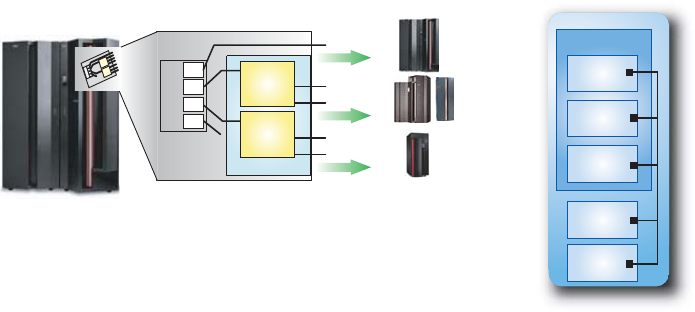
37
• ICB-3. The Integrated Cluster Bus-3 is used to provide
high-speed coupling communication between a z990
server or CF and a z800/z900 server or CF or between
two z800/z900s over short distances (~7 meters). For
longer distances, ISC-3 links must be used. The z990
features the STI-3 card which resides in an I/O cage and
provides 2 ICB-3 ports each capable of up to 1 GBps.
The ports are activated in one port increments. Up to 8
STI-3 cards, 16 ICB-3 links are available on the z990.
ICB-3 links operate in “Peer Mode.”
• ICB-4. The Integrated Coupling Bus-4 is a “native” cou-
pling connection available for connecting a z990 server
or CF to another z990 server or CF over short distances.
Capable of up to 2.0 GBps, the ICB-4 is the fast external
coupling connection available for the z990. The ICB-4
connection consists of one link that directly attaches to
an STI port on the system and does not require connec-
tivity to a card in the I/O cage. One feature is required
for each end of the link. Up to 16 ICB-4 features can be
confi gured on a z990 depending on model selected.
• IC. The Internal Coupling channel emulates the Cou-
pling Links providing connectivity between images
within a single server. No hardware is required, however
a minimum of 2 CHPID numbers must be defi ned in the
IOCDS. IC links provide the fastest Parallel Sysplex con-
nectivity
Intelligent Resource Director
Exclusive to IBM’s z/Architecture is Intelligent Resource
Director (IRD), a function that optimizes processor and
channel resource utilization across Logical Partitions
(LPARs) based on workload priorities. IRD combines the
strengths of the zSeries LPARs, Parallel Sysplex clustering,
and z/OS Workload Manager.
Intelligent Resource Director uses the concept of an
LPAR cluster, the subset of z/OS systems in a Parallel
Sysplex cluster that are running as LPARs on the same
zSeries server. On a z990, systems that are part of the
same LPAR cluster may be in different LCSSs. In a Parallel
Sysplex environment, Workload Manager directs work to
the appropriate resources based on business policy. With
IRD, resources are directed to the priority work. Together,
Parallel Sysplex technology and IRD provide fl exibility and
responsiveness to on demand e-business workloads that
is unrivaled in the industry.
IRD has three major functions: LPAR CPU Management,
Dynamic Channel Path Management, and Channel Sub-
system Priority Queuing.
IRD Scope
ICB-4 (2.0 GBps)
ICB-3 (1 GBps)
ICB-3 (1 GBps)
ICB-2 (333 MBps)
ICB-2 (333 MBps)
z990
z90
0
z80
0
G5/G6
STI
STI
STI
STI
M
B
A
I/O Cage
STI-3
MUX
STI-2
MUX
4 x 2.0 GBps
STIs
4 x 2 GB/s
STI
I/O Cage
S
T
I-
3
M
U
X
S
T
I-
3
M
U
X
B
A
M
S
T
I
S
T
I
S
T
I
S
T
I
LPAR Cluster
z/OS
z/OS
Linux
OS/390
ICF


















